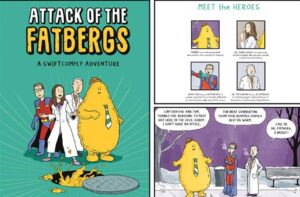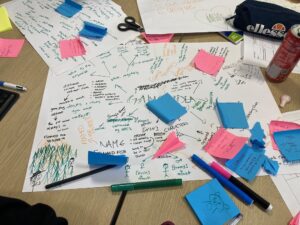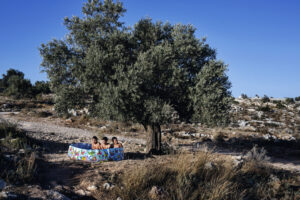Writing about nature, the role of literature in a crisis, sea spaces and poly-curiousity with John Brannigan, School of English, Drama and Film.
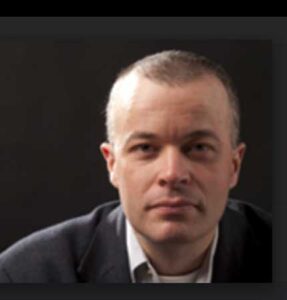
Professor John Brannigan |
Q: Can you introduce us to your own research, in particular your interest in environmental humanities and how you found this?
A: I’m a literary and cultural historian focussing on British and Irish literatures of the 20th century, principally. Largely my work is focused on how literature engages with social and cultural identities, in particular with narratives and the imagination of place. That has led me to focus on a number of different authors and periods, sometimes based around particular experiences or ideas in relation to gender or class or race, but it has also led me to more general interest in how literature is shaped by environments.
Questions that have often preoccupied my research are about how literary forms are associated with particular environments. So, are there particular forms in literature that emerged from the city, for example? There’s a particularly rich literature around islands. You find in children’s literature that there are certain environments that have symbolic significance, like forests which will always appear in a particular way in children’s literature. Islands will always have a mystical, magical kind of connotation in literature. I’ve always been interested in how literature reflects those ideas about environments, the particular cultural meanings of environments.
I was also interested in the other direction, not just how literature reflects environments, but also how literature shapes the public imagination of those environments. It’s that kind of shaping capacity that motivates my interest in working with environmental scientists, exploring the ways in which literature can actually shape how people feel about their environment, how they care about their environment.
Q: Tell me about the emergence of environmental humanities as a field, does it have a long lineage? What’s the place of English literature within it?
A: Environmental humanities has got a long lineage. Concerns about nature and how nature is represented have always been fairly prominent in literature, but environmental humanities gives us a way of framing that interest in a way that’s kind of new. English is a key discipline in environmental humanities and has been probably for about twenty years or so. One reason is how literature is a technology for representation. That’s to say that plays and poems, novels, stories, these are ways of imaginatively modelling the world around us. This helps us to recognise some things about the world that pass us by in everyday life. There’s a particular way in which literature slows down our attention and makes us pay attention to things around us.
“Very often, you find that literary celebrations of nature or particular places are actually to do with environmental change, a kind of threatened loss of that environment. So the romantics were kind of environmental campaigners in their own time, and were very concerned about environmental justice”
– Prof John Brannigan
The second reason why English has been important to the Environmental Humanities is that there is lots of evidence in literature of the past of writers being concerned about environmental change and about environmental justice. If you think about a really famous poem like Wordsworth’s Daffodils, ‘I wandered lonely as a cloud / That floats on high o’er vales and hills / When all at once I saw a crowd / A host, of golden daffodils’ – many people reading this will recall those lines from school. I think the Romantics are key to this because they were writers who we often associate now with celebrating nature in a particular way.
Even that poem about daffodils which has become a bit of a cliche, and people tend to think of it as a sort of very simple celebration of nature, Wordsworth is actually writing a poem about a part of the Lake District that’s being threatened by a railway line, by industrialisation. So, very often, you find that literary celebrations of nature or particular places are actually to do with environmental change, a kind of threatened loss of that environment. So the romantics were kind of environmental campaigners in their own time, and were very concerned about environmental justice.
Writers were writing about places and environments in very similar ways to the way the contemporary environmental writers would recognise and emulate. Very often they’re writing about rivers in a way that recognises the ecology of rivers or the watersheds of rivers like we know from environmental campaigning perspectives, as pertaining to the idea of a bio region for example. Very often there’s a close relationship, I think, between how writers write about environments and how environmental campaigners think about environments. There’s also such a rich literature around particular kinds of environments. This is why English is a really important discipline for environmental humanities, in terms of what kinds of evidence you can get from literature about environmental change.

Earth Institute researchers, Fran Ryfield and David Cabana, studying debris on Bull Island
Q: I have heard people talk about the use of literature to give insight into the environmental conditions at a particular historical period, even to something as simple as the weather
A: Yes. I mean it doesn’t replace any kind of statistical record, but it gives you a sense of how people feel about the weather around them, what looked kind of normal to them. Also, and I’ve not been involved in this myself, but there are a number of environmental humanities researchers who’ve looked at literature of the past to see, for example, what species of birds seem to be common in poetry at particular times, species which are now threatened with extinction.
Q: In what sense would you say you’re a historian?
A: I describe myself as a literary and cultural historian, primarily because what I’m interested in is not just the history of literature as an aesthetic form, but the history of how literature has engaged with the past, with change. I’m teaching a module at the moment to first year students called Literature and Crisis. It’s a new module and I’m finding it really exciting. I hope the students are too, by the way. We’ve organised it around how literature responds to crises through time, so we started, obviously enough, with the pandemic. We’ve got texts about the Black Death in the Middle Ages, texts about the AIDS crisis, science fiction stories about pandemics, and then we move on to environmental crises and climate crises, and into social and political crises.
In each case what we’re looking at is how can literature imagine these crises and what good is literature in a crisis. If there’s a fire in your kitchen you’re not going to turn to literature, but there are ways in which the climate crisis needs literature, for example. In the current health crisis, there has been a huge rise in the number of people wanting to read about past pandemics, you know, turning to books novels about pandemics. That’s a really interesting phenomenon, to see why people turn to fiction like this in times of crisis.
Q: So this type of literary studies is about looking at literature as response to perhaps broader, environmental, social and economic changes that were happening when it was written?
Absolutely, and it’s also trying to explain how literary form changes as a result of the things that are going on around it. I mean, the narrative that I was used to when I was a student was that change happens as a result of individual geniuses: you know, James Joyce wakes up one morning and thinks, I’ll completely mess about with the form of the novel today. Whereas, as a literary and cultural historian I tend to be more interested in trying to explain about other aspects of what was taking place in society around that time that might have led to those innovations. It’s no coincidence, for example, when we look at modernism in the early 20th century and the huge aesthetic innovations that were coming into literary form around that time, that it’s also a time of political revolution and huge social and cultural change, huge change in terms of industry, the First World War, and so on.
Q: You have said that you’re interested in social and cultural identities including a sense of place. Does that bring you into dialogue with other disciplines? Geography would be an obvious one. David Harvey featured on a Postmodernism course when I did English (quite a few) years ago!
A: Yes, absolutely and I’ve turned to David Harvey again in more recent years. I would have read The Condition of Postmodernity when I was a student as well. Place is a key concept in my work because it allows us to think about how ecology and culture are interdependent. Seamus Heaney once wrote about sense of place, that it was an ‘equable marriage between the geographical country and the country of the mind’, you know, between the physical and the ecological aspects of a place and its mental and emotional associations. So that concept of sense of place allows us to think about how people value their environment, which is obviously shaped by flora and fauna, by geography, by the weather, but also by the meanings which places accrue over time. Those meanings are accessible through cultural means so there’s a history of place, there’s a folklore of place, there’s a literature of place, which are an integral part of how people value it. Sense of place is an inherently interdisciplinary concept and absolutely draws from geography, from philosophy, from history, anthropology, sociology, and languages and literature. Literary scholars, I always think are like magpies or jackdaws. We’re kind of interested in stealing shiny things from other disciplines. Or maybe a kinder way of saying it is that literary scholars are or try to be polymaths, or at least poly-curious.
Q: You’re interested in seas and oceans and islands, would you like to talk a little bit about what draws you to these aspects of the environment?
For most people who do research on the sea, I guess there’s a personal narrative and an academic one. There’s a module that I teach in English on the literature of the sea and I always start by asking students what their experience of the sea is, what they associate with the sea. You always get a really interesting mix of responses, from seaside childhood experiences to students who are the children of fishermen, you get students who love surfing and swimming, and so on. For me it was a similar kind of mix, I’ve got very happy memories of the seaside but I hadn’t really done anything on the sea early on in my academic career. What turned me towards it was two things. As a parent, I was reminded again just about how amazing the seaside is, you know, as a place of entertainment, a place of fun, a place of endless stimulation. You bring children to a beach, you can sit and read your book for hours on end. Kids are just endlessly amused there so I’ve always been interested in why that is. What is it about the seaside that has that kind of magical quality? In a sense, those are kind of personal motivations for trying to find out why people are interested in the sea and drawn to the sea in that way.
I’m also interested in how the sea is imagined as a wild place and how the sea is often imagined in literature as a kind of void. I’m interested as well in the history of ships, on the significance of ships in literature. It’s a huge area to explore and it’s very interesting, because there are continuations between what happens at sea and what happens on the land, but there are also huge differences. Michel Foucault, the French historian, has written about how ships are like alternative societies, heterotopias, experimental societies which are almost always overwhelmingly male which produces a kind of different dynamic. They’re also often outside the usual laws and conventions of morality, the usual social conventions.
Ships are often also vehicles of dreams, dreams of freedom, or embody getting away from society. On the course I teach on Literature and the Sea, the first text we do is Moby Dick and I think the students are often surprised just what’s possible to happen at sea, which is quite different from landed society. There are possibilities there for how we use the sea and ships, to think about society differently, to think about what happens when we’re able to escape those normal laws of society. And of course, there are lots of bad things that happen at sea. So, on the one hand, there’s the sort of magical quality of ships that they take you to exotic lands, but, on the other hand, we need to remember that there’s also the whole history of colonialism, slavery, and war that depends on maritime voyages.
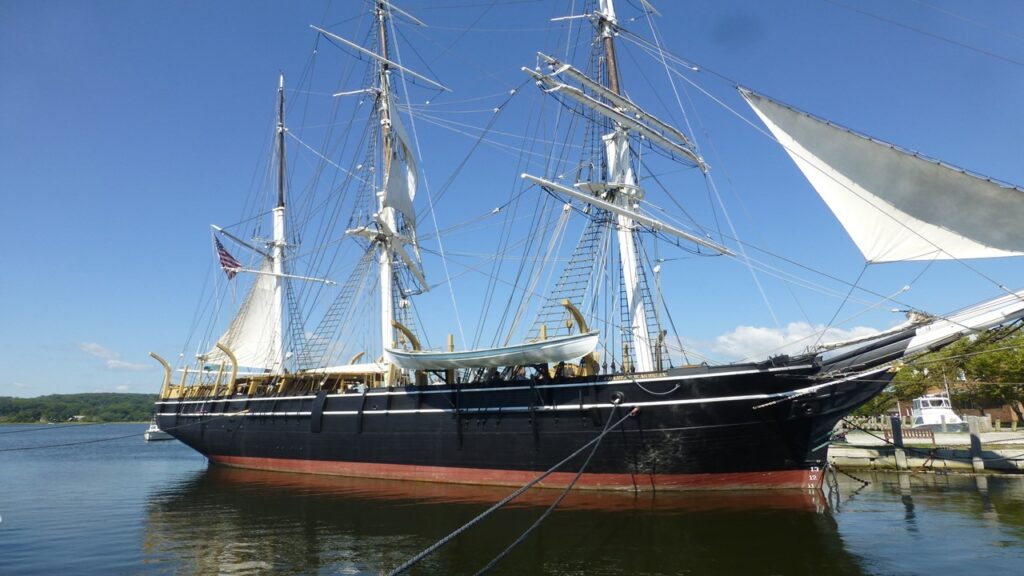
Whaling ship Charles W. Morgan, the model for the Pequod in Herman Melville’s Moby Dick, now located in Mystic Seaport Museum, Connecticut
Q: I read a quote where you talk about the Irish sea, and say that for far too long, the waterway between these islands has been viewed more as a “barrier” than as a “shared space”. Tell us a bit about that.
A: I think in different disciplines, it has different resonances. I was conscious when I started doing more research on literature and the sea, one of the things that attracted me was that thinking about literature in terms of sea spaces was a way of moving away from the limitations of thinking about literature in terms of nations all the time. So in literary studies, as you know, we tend to have courses on Irish literature, courses on American literature, Caribbean literature and so on. They’re very terrestrially based. I was interested in what happens when you begin to think about literature in terms of sea spaces, are there ways in which writers who share the same sea space, however small or large that is, share other things too? How does the sea connect people?
What I discovered is that when you move between different disciplines that has completely different resonances. In literary studies, colleagues would look at me as if I was a bit mad when I asked this question about sea spaces, but if you go down to Archaeology, they study cultures developing around sea spaces all the time, it’s familiar to them. I remember having a meeting with our colleagues from Archaeology in UCD and I had organised it informally, saying I’d like to meet anybody with an interest in the Irish sea as a sea space. I turned up from literature and eight people turned up from Archaeology. To them, the idea that culture could be defined by a sea space was not an unusual concept, it was fundamental.
In literary studies it was more unusual. Probably about ten years ago or so, people began to write more about sea spaces as connective in literature. Rather than talk about Irish literature, could you say that there is a difference between writers of the Atlantic coast and writers of the Irish Sea coast? Are there things that the Irish Sea coast writers share with people who are on the Cumbrian coast on the west coast of England, for examples. I found there was quite a lot of commonality when looking at writers on either side of the Irish Sea, whereas there might be a lot of things in common between writers on the Atlantic coast here and writers on the Scottish Atlantic coast. Sea spaces give us ways of thinking about literature and culture that kind of go beyond that national framework.
“Ocean currents affect the movement of species, the movement of flora and fauna. You can also study the ways in which seas and oceans are circulatory systems when it comes to pollution, like plastics etc. Likewise, seas and oceans are circulatory systems for culture”
– Prof John Brannigan
In some ways that’s not new, you know, if you think about Atlantic studies, for example. Paul Gilroy is influential in terms of his analysis of the black Atlantic. In order to understand African American literature, for example, to some extent you have to look at the relationship with Caribbean literature and with African literature. Because of the historical connections through slavery, because of the black Atlantic, because of what that entailed. In a way, what Gilroy was doing in that book was proposing something very familiar to ecologists, that seas and oceans are circulatory systems, that you can study from an ecological point of view. Ocean currents affect the movement of species, the movement of flora and fauna. You can also study the ways in which seas and oceans are circulatory systems when it comes to pollution, like plastics etc. Likewise, seas and oceans are circulatory systems for culture.
Q: You’ve worked in very interdisciplinary ways looking at coastlines and cultural ecosystems services. Tell us a bit about some of that work.
The Cultural Value of Coastlines project was an important pilot project that Tas Crowe and I designed together. We had collaborated before on organizing some symposia, the first of which was about the Irish Sea as both a cultural space and an ecological space. The whole idea of that symposia was to bring together environmental scientists and environmental humanities researchers. The second symposium was called ‘Women and the Sea’. This was really recognising that, as we were talking earlier about ships, there is a very masculine history around maritime spaces. We were interested in that lesser-known maritime history, about women and the sea.
Both symposia were really designed to bring the humanities and sciences together to see what kind of conversations would develop around them and what kind of models might be applicable for both kinds of researchers to work on. Out of this came the Cultural Value of Coastlines project, which was funded by the Irish Research Council under a really great scheme, called the New Horizons scheme, which was based on Arts, Humanities and Social Sciences researchers partnering with STEM researchers. The PIs are made equal partners and given responsibility to bring the subjects together. The key idea was to develop a way of using humanities and social sciences based research on cultural representations and social surveys to provide evidence of how people valued coastal environments and to combine this with knowledge of how those coastal environments are changing ecologically.
We had two postdoctoral fellows join our team, Fran Ryfield, who is a human geographer and David Cabana, a marine ecologist. The key thing about the project was that we did all of the research together as a team; field research, participatory surveys, expert focus groups, they were all designed and conducted together. We didn’t want anybody going off into their silos. So we were learning from each other all the time about what these different things meant in different disciplines. The most important thing for us was visiting the case study sites that we chose together.
There are lots of really, really rich outputs from the project; publications and presentations and so on, but I think probably, the thing that we’re most proud of is that both postdocs went straight into jobs at the end of the project that enabled them to continue to use the interdisciplinary methods that we developed as a team in in the project. That project ended in 2019 and we have tried to take lessons from that project into subsequent projects, currently, for example in the Land2Sea project. Much of that research is based upon the idea of cultural ecosystem services. The Cultural Value of Coastlines project used the ecosystem services framework to develop a way of integrating humanities and sciences knowledge and was specifically designed to make an intervention in how we go about providing evidence of cultural ecosystem services.
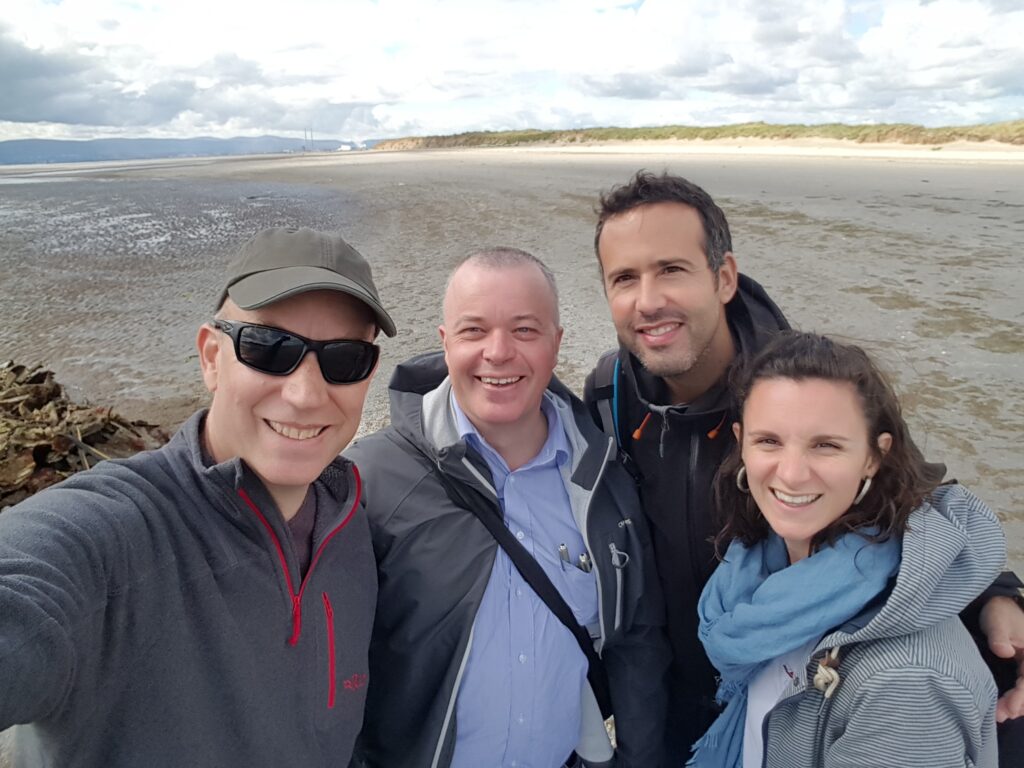
The Cultural Value of Coastlines research team: Tas Crowe, John Brannigan, David Cabana, Fran Ryfield.
Q: Can you explain a little about what cultural ecosystem services are, for anyone who might not have heard the term?
Ecosystem services is a framework for understanding the services to human society an ecosystem provides. It includes provisioning services, such as the water and food we get from the environment , and then regulatory services, like cleaning processes and waste absorption and so on. Cultural services have always been in there too, but the difficulty with them was it was primarily economic ways that were used to determine the value of ecosystem services. This works for a lot of provisioning services and for some regulating services, but just isn’t very good for evaluating cultural ecosystem services. It was really Tas’s idea that there was a gap in the model, and that the research we were doing could make an impact in terms of supplying evidence of those cultural ecosystem services. Humanities and social sciences research would help to build a more comprehensive model and a more useful model – because the framework is really useful in terms of environmental management.
Often what happens is that cultural ecosystem services are just ignored. Yet they’re important, I think, because cultural ecosystem services are usually the things that inspire deep attachment to places in people. The reasons why people care about – as we were finding in Dublin Bay, for example – the reason they care about that environment is not because there are particular fish in in the sea or because there’s a kind of waste water service provided. It’s because of cultural ecosystem services, because of the kind of aesthetic attachments or symbolic meanings or heritage meanings or in some cases spiritual attachments to place.
What we found is that there was a way of calculating some these cultural ecosystem services, economically. There were tourism benefits and there were leisure benefits, and you could calculate what that meant economically to the local economy, but you couldn’t calculate how people feel about their environment, what it means to them to come to a particular place, to do this thing or that thing. There are lots of people around Dublin Bay who go for a dip every day and when you talk to those people about why they do it, it’s not something that’s replaceable with something else. They are attached to a particular place, to a particular kind of cultural meaning. We tried to show this. We used a social survey which captured lots of information about how people feel, where people could upload photographs as well as comment. We got this really rich body of quantitative and qualitative research that we could rely on.
Then the other element of it was that we could look at paintings, at poems, at novels and so on, and look at all the kinds of literature that’s been set around Dublin Bay. Why are writers drawn to these places? What are the values that they’re representing in these places? And that gives us some information as well, which we were able to put into things like Storymaps, to show how you could map this out and you could show there are particular hot points that writers and artists have been drawn to. It became a really important way of integrating humanities-based evidence and social sciences based evidence into this model of evaluating ecosystem services. That was the methodological outcome.
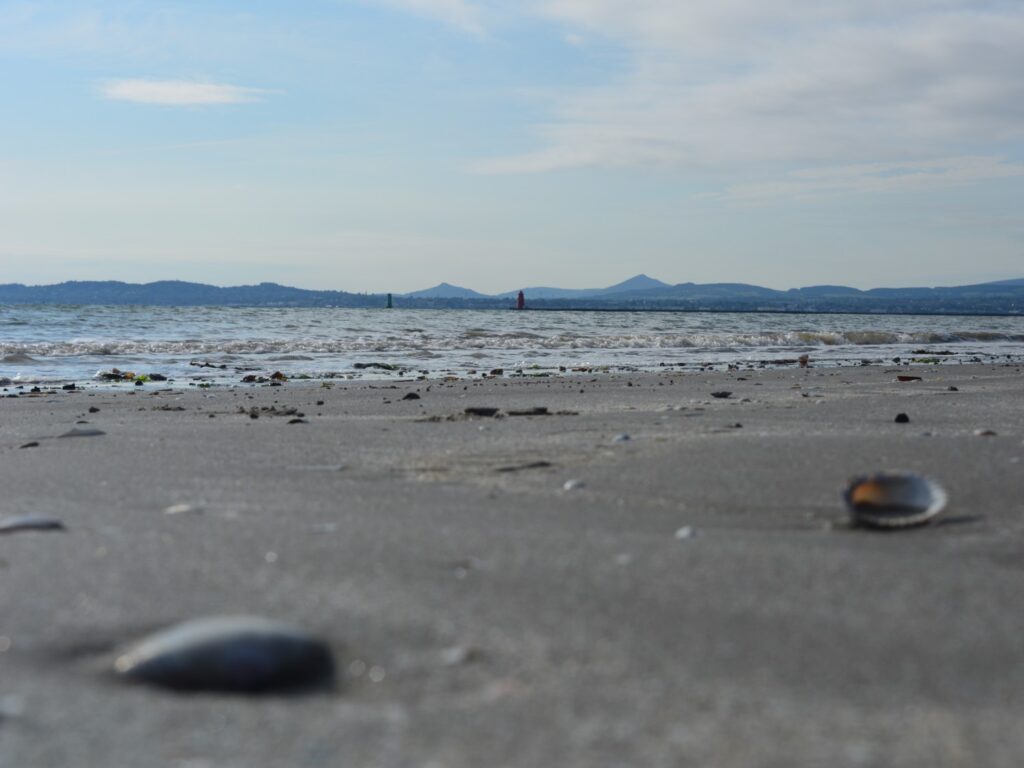
Dublin Bay
Q: It sounds like it was a very successful project in terms of its interdisciplinarity, but that in itself required time and effort to make it truly work. It can be hard to do this kind of research when there are barriers in publishing and even in the structures of universities to working in this way. What do you think needs to change in the system to make to encourage interdisciplinarity?
Tas and I have talked quite a lot about this. We were very conscious of that when designing the project because there are a number of things that actually made that project possible, which I think are indications of the right things that you need to have in place. One was the right funding mechanisms which enable parity between the disciplines, from seed funding through to larger scale projects. And one of the things we did when we finished the project was actually to write directly to the IRC to say, please keep going with the New Horizons scheme. I think it’s now transformed into the COALESCE scheme. There needs to be equality and parity between the disciplines. It really meant that Tas and I were co-directors, from the beginning, so it wasn’t a humanities researcher coming over to an ecologist and asking can you help me with this service. It was about designing it together and running it together.
The second thing is, I think you know, that in UCD like many other universities, almost everything in the university is organised through schools, through disciplines. The major thing that helped with our project was obviously research institutes. So, in our case, right from the beginning in the symposia that we organised, for example, they were jointly organised and funded by the Earth Institute and the Humanities Institute. The research institutes, I think, are really, really key for providing a home for interdisciplinary projects.
Now there are still many barriers to interdisciplinary research. We were aware from the beginning that one of the things that enabled our project to happen was that Tas and I were at a certain stage, shall we say kindly, an advanced stage in our careers, where we didn’t actually need to worry about the consequences for our careers of being involved in a project like this. The reason why I say that is because I think it is really risky for an early career scholar to get involved in a project like this, because as disciplines our means of kind of measuring success is not really readable to each other.
In the humanities, for example, we’re simply not used to co-authoring with multiple authors. We struggle to recognise what it means if you’re the third or the fourth author. When candidates for jobs come before humanities selection boards, for example, and they’ve mostly got a history of co-authoring, it’s very difficult for the panel to assess what the individual contribution to that is. In the humanities, we don’t read citation scores, in the same way as scientific disciplines. I would even go so far as to say in humanities, scholars are more likely to be cited frequently if they get things wrong, or if they say things that are controversial. Whereas in the sciences your citation score is everything.
We have these very different ways of going about things, so it’s a real risk for early career scholars to engage in an interdisciplinary project which might end up with publications that are simply not readable when they try to get jobs in their own discipline. One of the things we did from the beginning was that we were conscious that one postdoc would be from the humanities, and one would be from the sciences. We were committed to having one journal publication in a humanities facing journal and one journal publication in a science journal, to ensure parity. So it is still difficult, I think, that kind of research, but hopefully the more that we do it and the more we show how, the more that there will be mechanisms there to recognise what success looks like.
